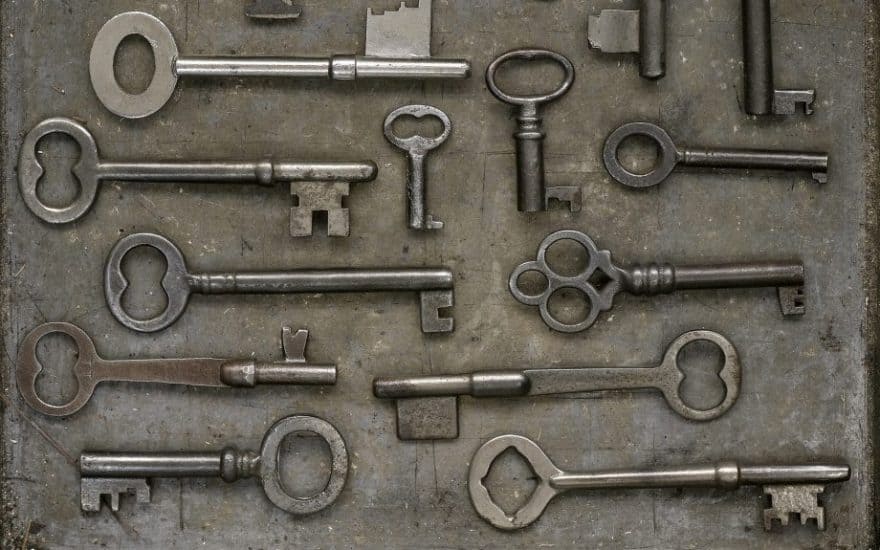Introduction
Keys are more than just small pieces of metal or plastic that unlock doors or start engines; they are symbols of security, access, and control. In today’s world, keys come in various shapes, sizes, and functions, each tailored to a specific purpose. This article explores 20 different types of keys, providing an informative overview of their unique characteristics and uses. Whether you’re interested in traditional keys, digital solutions, or specialized keys, this guide will give you a comprehensive understanding of the diverse world of keys.
1. Skeleton Key
A skeleton key is a type of master key that can open numerous locks, typically used for warded locks. Though often depicted in fiction as a key that can open any door, in reality, it is only effective on a specific type of lock.
2. Padlock Key
Padlock keys are designed to unlock padlocks, which are commonly used to secure gates, lockers, and other portable security needs. These keys are typically small and often come in various shapes to match the specific padlock.
3. Car Key
Car keys have evolved significantly from traditional metal keys to sophisticated remote-controlled devices. Modern car keys often include electronic transponders, which are programmed to communicate with the vehicle, enhancing security.
4. House Key
House keys are among the most common types of keys and are typically used for residential locks. They are usually flat and cut with a unique pattern that corresponds to a particular lock, ensuring only one key can open it.
5. Master Key
A master key is designed to open multiple locks within a particular group, making it ideal for use in hotels, offices, or large buildings where different doors require access by various personnel.
6. Magnetic Key
Magnetic keys use magnetic strips or coded magnets to operate locks. These are often found in hotels, office buildings, and high-security areas where traditional keys may not be sufficient.
7. Transponder Key
Transponder keys are commonly use in modern vehicles. They contain a microchip that transmits a unique code to the car’s ignition system, ensuring that only the correct key can start the vehicle.
8. Tubular Key
Tubular keys are cylindrical and used in locks with a corresponding tubular design. They are often found in vending machines, bicycle locks, and computer locks, offering enhanced security due to their complex shape.
9. Double-Sided Key
Double-sided keys have cuts on both sides of the blade, providing extra security and making them harder to pick. These keys are often use in residential and commercial locks.
10. Dimple Key
Dimple keys have indentations rather than traditional cuts. These indentations align with corresponding pins inside the lock, providing a secure mechanism that is difficult to duplicate.
11. Smart Key
Smart keys are a modern innovation, often used with cars and homes. They rely on wireless technology to communicate with the lock, allowing keyless entry and ignition. Some smart keys can even be integrate with smartphone apps.
12. Cruciform Key
Cruciform keys, also known as cross keys, have a unique cross-shaped design. They are typically used in high-security applications such as safes and commercial properties.
13. Paracentric Key
Paracentric keys are use in paracentric locks, which have complex, narrow keyways designed to prevent lock picking. These keys are often use in prisons and high-security facilities.
14. Abloy Key
Abloy keys are associate with disc tumbler locks, known for their durability and resistance to picking and drilling. These keys are often use in secure facilities where high levels of protection are needed.
15. Barrel Key
Barrel keys have a hollow shaft and are commonly use in antique furniture locks, small padlocks, and certain types of safes. Their unique design adds an extra layer of security.
16. Flat Key
Flat keys are commonly use in wafer tumbler locks, such as those found in filing cabinets and desk drawers. They are simple, flat, and easy to use.
17. Keycard
Keycards are a modern alternative to traditional keys, often used in hotels and office buildings. They use a magnetic stripe or RFID technology to grant access, providing a convenient and secure solution.
18. Restricted Key
Restricted keys are specially designe to prevent unauthorize duplication. They are often use in commercial settings where security is paramount, and only authorized personnel can obtain copies.
19. Zeiss Key
Zeiss keys are unique, double-bitted keys used in high-security locks, such as those found in banks and safes. Their intricate design makes them extremely difficult to replicate.
20. Mul-T-Lock Key
Mul-T-Lock keys are associate with high-security locks that use a combination of pin tumblers and telescopic pins. These keys offer superior protection against picking, bumping, and drilling.
Conclusion
Understanding the various types of keys available today is essential for selecting the right security solutions for your needs. Whether you require a simple house key, a sophisticated smart key, or a specialized key for high-security applications, the options are vast and varied. Each type of key serves a unique purpose, ensuring that security can be tailore to meet specific requirements. As technology continues to advance, the evolution of keys will likely bring even more innovative solutions to the world of security.

